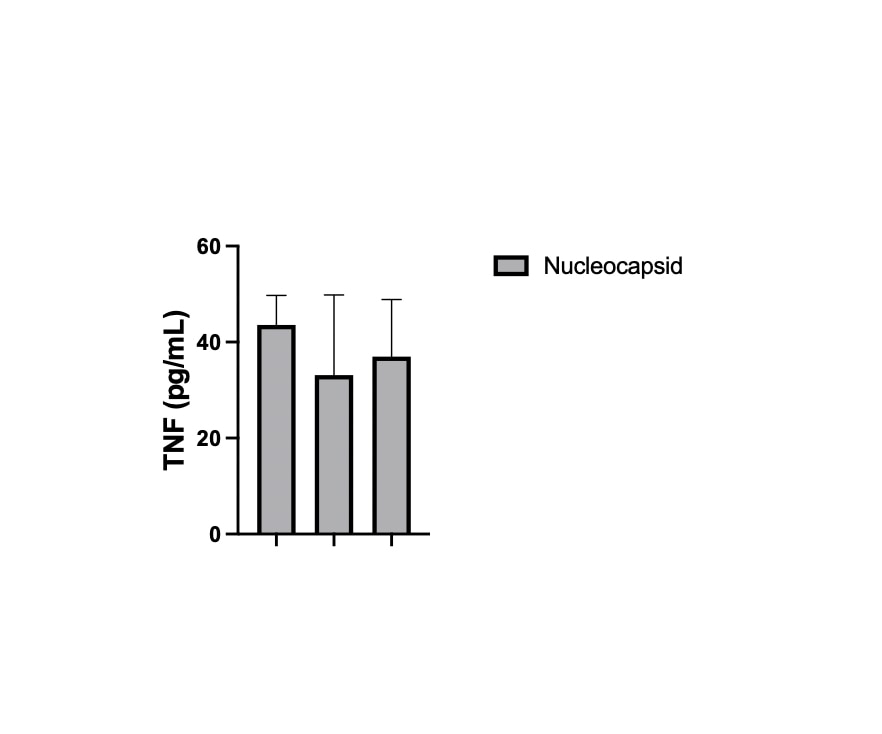Recombinant SARS-CoV-2 Nucleocapsid His Protein, CF
Recombinant SARS-CoV-2 Nucleocapsid His Protein, CF Summary
Product Specifications
Met1-Ala419, with a C-terminal 6-His tag
Analysis
Product Datasheets
Carrier Free
CF stands for Carrier Free (CF). We typically add Bovine Serum Albumin (BSA) as a carrier protein to our recombinant proteins. Adding a carrier protein enhances protein stability, increases shelf-life, and allows the recombinant protein to be stored at a more dilute concentration. The carrier free version does not contain BSA.
In general, we advise purchasing the recombinant protein with BSA for use in cell or tissue culture, or as an ELISA standard. In contrast, the carrier free protein is recommended for applications, in which the presence of BSA could interfere.
10474-CV
| Formulation | Lyophilized from a 0.2 μm filtered solution in PBS. |
| Reconstitution | Reconstitute at 500 μg/mL in PBS. |
| Shipping | The product is shipped at ambient temperature. Upon receipt, store it immediately at the temperature recommended below. |
| Stability & Storage: | Use a manual defrost freezer and avoid repeated freeze-thaw cycles.
|
Scientific Data
 View Larger
View Larger
2 μg/lane of Recombinant SARS-CoV-2 Nucleocapsid His Protein (Catalog # 10474-CV) was resolved with SDS-PAGE under reducing (R) and non-reducing (NR) conditions and visualized by Coomassie® Blue staining, showing bands at 44-53 kDa.
Reconstitution Calculator
Background: Nucleocapsid
SARS-CoV-2, which causes the global pandemic coronavirus disease 2019 (Covid-19), belongs to a family of viruses known as coronaviruses that are commonly comprised of four structural proteins: Spike protein (S), Envelope protein (E), Membrane protein (M), and Nucleocapsid protein (N) (1). While the S, E and M proteins build up the viral envelop, the N protein is involved transcription, replication and packaging of the viral RNA genome into a helical ribonucleocapsid (RNP) (2, 3). The SARS-CoV-2 N protein is a ~45 kDa protein composed of two independent structural domains connected by a linker region. The N-terminal region contains an RNA binding domain, the linker region interacts with the M protein and the C-terminal region contains a self-association domain (2,3). The SARS-CoV2 N protein shares 91% and 47% amino acid sequence identity with SARS-CoV-1 and MERS N protein, respectively. The SARS-CoV-2 N protein displays VSR (viral suppressor of RNA interference) activity in mammalian cells (4). In addition, the N protein is an abundant protein during coronavirus infection and displays high immunogenic activity (5, 6), so it has been used to develop serological diagnostic kit for Covid-19 IgM and IgG antibody tests (7).
- Wu, F. et al. (2020) Nature 579:265.
- Chang, C. K. et al. (2006) J. Biomed. Sci. 13:59.
- Hurst, K. R. et al. (2009) J. Virol. 83:7221.
- Mu, J. et al. (2020) Sci. China Life Sci. doi: 10.1007/s11427-020-1692-1.
- Che, X. Y. et al. (2004) J. Clin. Microbiol. 42:2629.
- Guan, M. et al. (2004) Clin. Diagn. Lab. Immunol. 11:287.
- Liu, W. et al. (2020) J. Clin. Microbiol. doi: 10.1128/JCM.00461-20.
Citations for Recombinant SARS-CoV-2 Nucleocapsid His Protein, CF
R&D Systems personnel manually curate a database that contains references using R&D Systems products. The data collected includes not only links to publications in PubMed, but also provides information about sample types, species, and experimental conditions.
4
Citations: Showing 1 - 4
Filter your results:
Filter by:
-
A new multiplex SARS-CoV-2 antigen microarray showed correlation of IgG, IgA, and IgM antibodies from patients with COVID-19 disease severity and maintenance of relative IgA and IgM antigen binding over time
Authors: ML Berre, T Paulov?áko, CM Verissimo, S Doyle, JP Dalton, C Masterson, ER Martínez, L Walsh, C Gormley, JG Laffey, B McNicholas, AJ Simpkin, M Kilcoyne
PLoS ONE, 2023-03-30;18(3):e0283537.
Species: Human
Sample Types: Serum
Applications: Binding -
A new multiplex SARS-CoV-2 antigen microarray showed correlation of IgG, IgA, and IgM antibodies from patients with COVID-19 disease severity and maintenance of relative IgA and IgM antigen binding over time
Authors: ML Berre, T Paulov?áko, CM Verissimo, S Doyle, JP Dalton, C Masterson, ER Martínez, L Walsh, C Gormley, JG Laffey, B McNicholas, AJ Simpkin, M Kilcoyne
PLoS ONE, 2023;18(3):e0283537.
Species: Human
Sample Types: Serum
Applications: Binding -
Evidence, detailed characterization and clinical context of complement activation in acute multisystem inflammatory syndrome in children
Authors: G Sinkovits, J Schnur, L Hurler, P Kiszel, ZZ Prohászka, P Sík, E Kajdácsi, L Cervenak, V Maráczi, M Dávid, B Zsigmond, É Rimanóczy, C Bereczki, L Willems, EJM Toonen, Z Prohászka
Scientific Reports, 2022-11-17;12(1):19759.
Species: Human
Sample Types: Recombinant Protein
Applications: ELISA Standard -
Calcium dobesilate reduces SARS-CoV-2 entry into endothelial cells by inhibiting virus binding to heparan sulfate
Authors: Y Kiyan, A Schultalbe, E Chernobriv, S Tkachuk, S Rong, N Shushakova, H Haller
Scientific Reports, 2022-10-07;12(1):16878.
Species: Human
Sample Types: Recombinant Protein
Applications: Bioassay
FAQs
-
What is the strain/variant of Recombinant SARS-CoV-2 Nucleocapsid His Protein, CF (Catalog # 10474-CV)?
Catalog # 10474-CV references accession # YP_009724397.2 which is the Wuhan strain (also known as Wuhan-Hu-1).
Reviews for Recombinant SARS-CoV-2 Nucleocapsid His Protein, CF
Average Rating: 4 (Based on 1 Review)
Have you used Recombinant SARS-CoV-2 Nucleocapsid His Protein, CF?
Submit a review and receive an Amazon gift card.
$25/€18/£15/$25CAN/¥75 Yuan/¥2500 Yen for a review with an image
$10/€7/£6/$10 CAD/¥70 Yuan/¥1110 Yen for a review without an image
Filter by:

